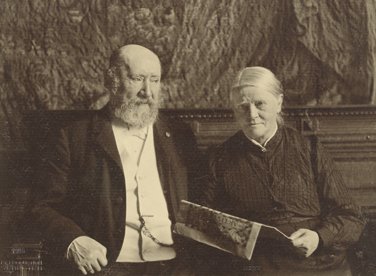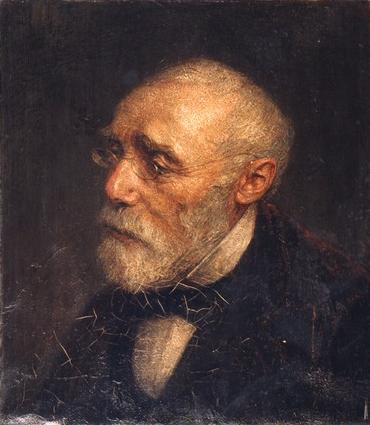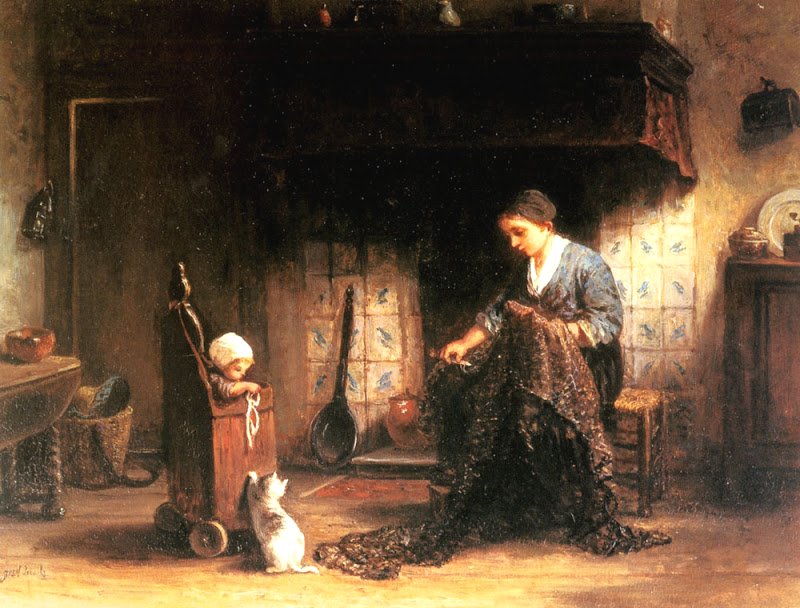
The person I am featuring today was an artist of great talent, an avid art collector and an owner of a museum, which housed many of the works he had collected during his lifetime. I talked briefly about him in my previous blog which was dedicated to his friend Jozef Israels. Let me introduce you to the marine painter, Hendrik Willem Mesdag.

Mesdag was born in Groningen in February 1831. His father Klaas was a banker and was also active in politics and his mother was Johanna Wilhelmina van Giffen, who came from a wealthy family of silversmiths. She died when Hendrik was four years old. Hendrik had two brothers, Gilles and Taco and a sister, Ellegonda. As schoolchildren, both he and his older brother showed and early artistic talent and their father, who was also an amateur artists, decided to send them for some artistic training. They both received drawing lessons from Bernardus Buijs who had also taught Jozef Israels and later received drawing tuition from Hinderikus Egenberger. However, for Hendrik, once he left school at the age of nineteen, art became just an enjoyable pastime, and his future, like that of his father, lay in banking. Hendrik Mesdag joined his father’s bank where he remained for the next sixteen years.

In April 1856, when Hendrik was twenty-five years old, he married Sientja van Houten, who would later become an accomplished artist in her own right. She was one of seven children brought up by a wealthy family. Her father owned a large sawmill just outside Groningen. Her cousin was the renowned painter Lawrence Alma-Tadema.

Hendrik’s love of art during his days as a banker did not diminish, in fact in 1861 he enrolled as a pupil at the Academie Minerva, a Dutch art school based in Groningen. In 1863 Sientje gave birth to their son Nicolaas, who was called Klaas. Hendrik’s love of art and his desire to become a full-time professional artist came to a head in 1866 when he decided to give up his work as a banker and concentrate on his art. To give up a lucrative job took courage but it also required funding and for this he had to thank his wife who had received a sizeable inheritance when her father died and she was able to support him financially.

Lawrence Alma-Tadema advised Hendrik to go to Brussels to study art and in the autumn of 1866 he goes to the Brussels for three years and studied art under the tutorship of Willem Roelofs, the Dutch painter and watercolourist. Fate played a hand in the artistic life of Mesdag in 1868 when he and his family went to Norderney for a holiday. Norderney is one of the East Frisian islands off the North Sea coast. It is here that Mesdag realises his love of the sea and seascapes and when he returns to Brussels he starts collecting paintings which depict the sea and it is from this time that he decides he wants to be a seascape artist.

Once he completes his three year study course in Brussels in 1869, the family move to The Hague where the sea views at the nearby coastal village of Scheveningen, would be plentiful. Hendrik was admitted to The Hague’s Pulchri Studio Painters’ Society. The society was formed in 1847 and was a result of mounting dissatisfaction among the young artists in The Hague who complained about their being little or no opportunities for training in art and developing their artistic skills and so the Pulchri Studio was established. It was also to be an artistic talking-shop where artists could exchange views and ideas.

It was in 1869 that Mesdag worked on his painting Les Brisants de la Mere du Nord (Breakers of the North Sea) which, when it was exhibited at the Paris Salon in 1870, was awarded the gold medal. In September 1871, tragedy struck Hendrik and Sentije when their eight year old son Klaas, their only child, died. It was from that time onwards that Sientje took up painting.

Hendrik Mesdag’s collection of paintings had grown so large that it filled his house and in 1878 he decided to build a museum in the garden, next to his house, to accommodate his ever-growing collection. That same year, his father Klaas died aged 85. Although most of the works of art by Hendrik Mesdag were seascapes and paintings depicting bomschuiten (fishing boats) one of his most famous works came about in 1879 when he received a commission from a group of Belgian entrepreneurs to paint a panorama. A panorama or panoramic painting was a massive work of art, which depicts a wide and all-encompassing view of a particular subject. They could be depictions of a battle, historical event or a landscape and were very popular in the nineteenth century, a time before television or the cinema. The commission was simple – the group wanted Mesdag to complete a painting without any borders ! The Belgians gave Mesdag free rein on the subject of the panorama and he was allowed to pick his team of artists to complete the task. The commission intrigued Mesdag and he agreed to it and formed a team of artists which included Théophile de Bock and twenty-three-year-old George Hendrik Breitner, who was still a student at The Hague Academy , the artist, Bernard Blommers , as well as his wife Sientje.

Mesdag decided this was an opportunity to depict his beloved coastal village of Scheveningen.
In March 1881, Mesdag and his team of painters set to work on the panorama. They made numerous sketches of the town and the surrounding coast and slowly over the next four and a half months the panorama often referred to as Panorama Mesdag evolved. The work when completed was 14 metres high with a circumference of 120 metres, a square footage of 1600 square metres. The finished work was housed in a purpose-built museum in The Hague and could be viewed from an observation gallery in the centre of the room. When one stood at this central observation point, it was if one was standing on top of a high sand dune and one could observe the sea, the beaches and the coastal village of Scheveningen. The museum housing the panorama was opened to the public on August 1st 1881 but after five years it went bankrupt. Mesdag , who was concerned as to the fate of his panoramic painting, bought the museum and kept it open despite it losing money year on year.

It is still open to the public and it is still one of the The Hague’s greatest tourist attractions. Can you imagine what it would be like to stand on that central observation platform – take a look now at http://panorama-mesdag.nl/ and see this wonderful work, which is the largest circular canvas in Europe.
In his later years Mesdag received many honours. In 1889, he was elected chairman of Pulchri Studio Painters’ Society, the society he joined twenty years earlier, and remained in that post until 1907. He received the royal distinction of Officer in the Order of Oranje-Nassau in 1894. In February 1901 Mesdag is promoted to Commander of the Order of the Dutch Lion.

In March 1909 his beloved Sientje died, aged 74. Two years later in 1911, Hendrik Mesdag is taken seriously ill and although he recovers, his health slowly deteriorates. Hendrik Willem Mesdag died in The Hague in July 1915, aged 84.
One may compare the seascapes and depictions of fishing boats with the artist, Jozef Israels, whom I looked at in my last blog. Israels’ depictions were often full of angst and doom and gloom whereas Mesdag’s works were simply depictions of what he saw, without any need to have the works populated by people and all had a story behind them. I end with a quote from the author, Frederick W Morton who wrote an artcle in the May 1903 edition of the American art journal, Brush and Pencil . He wrote about Mesdag’s seascapes:
“…Other artists have painted more witchery into their canvases, more tenseness and terror. A Mesdag has not the glint of colour one finds in a Clays or the awful meaning one reads in Homer. On the contrary, many of his canvases are rather heavy in tone and are works calculated to inspire quiet contemplation rather than to excite nervous. But he is a great marine-painter because he thoroughly knows his subject – he has sat by it, brooded over it, studied it in its every phase – and by straightforward methods, without the trick of palette or adventitious accessories, has sought to make and has succeeded in making his canvases convey the same impression to the spectator that the ocean conveyed to him…”
———————————————-
Much of the information for this article came from the Mesdag Documentation Society and their excellent website Mesdag.com (http://www.mesdag.com/index.html)




























